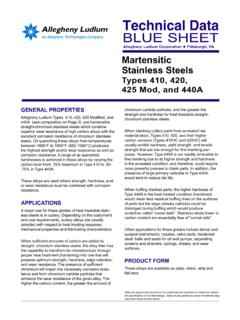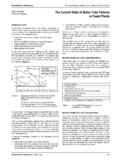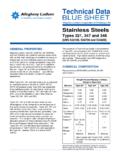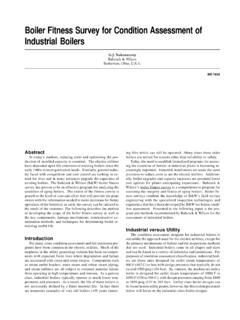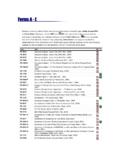Transcription of 01423: CORROSION PROTECTION OF KRAFT …
1 Paper No. 01423. CORROSION 2001. CORROSION PROTECTION OF KRAFT digesters . Angela Wensley Pulp & Paper CORROSION Specialist D. Angela Wensley Consulting Engineering Services 15397 Columbia Avenue White Rock, BC, Canada V4B 1K1. ABSTRACT. This paper discusses novel applications of anodic PROTECTION , weld overlay, and thermal spray coating for CORROSION PROTECTION of carbon steel batch and continuous digesters . Anodic PROTECTION now offers the possibility of protecting behind screens and blank plates. Stainless steel weld overlay can be applied behind headers for PROTECTION against erosion- CORROSION . Thermal spray coatings can be applied over circumferential weld seams for PROTECTION against stress CORROSION cracking.
2 Also discussed are the advantages and disadvantages of each PROTECTION mode as well as their compatibility with each other. Keywords: acid cleaning, anodic PROTECTION , clad plate, digesters , duplex stainless steel, erosion- CORROSION , intergranular attack, pitting, pulp and paper, stress CORROSION cracking, thermal spray, weld overlay INTRODUCTION. Digester vessels (including impregnation vessels) constructed using carbon steels or austenitic stainless steels experience CORROSION problems that may inevitably require some form of PROTECTION so that they can safely remain in service. CORROSION problems experienced in digester vessels includel: CORROSION Mechanism Continuous digesters Batch digesters Caustic stress CORROSION cracking of carbon steel.
3 Yes Rare CORROSION thinning of carbon steel. Yes Yes Preferential CORROSION of carbon steel welds Yes Yes Erosion- CORROSION of carbon steel. Yes Rare Acid cleaning damage of carbon and stainless steel. Yes No CORROSION thinning of stainless steel. No Yes Intergranular attack of stainless steel. Yes Yes Stress CORROSION cracking of stainless steel. Yes Yes MECHANISMS OF CORROSION IN digesters . Stress CORROSION Cracking of Carbon Steel Caustic stress CORROSION cracking (SCC) is the most serious form of CORROSION that can occur in a continuous digester and has resulted in the catastrophic failure of a continuous digester. SCC affects mainly welds in the impregnation zone or in Copyright 2001 by NACE International.
4 Requests for permission to publish this manuscript in any form, in part or in whole must be in writing to NACE. International, Publications Division, 1440 South Creek Drive, Houston, Texas 77084-4906. The material presented and the views expressed in this paper are solely those of the author(s) and not necessarily endorsed by the Association. Printed in the impregnation vessel in two-vessel systems. SCC occurs only within a narrow range of CORROSION voltage potentials. In the impregnation zone of a digester the CORROSION potential can remain in the SCC range long enough for cracks to initiate and propagate. Continuous digesters that were not post-weld heat treated or only partially stress relieved have high residual tensile stresses especially at welds and in conical sections and are most susceptible to SCC.
5 SCC is rare in batch digesters due to the cyclic nature of their operation. The CORROSION potential in batch digesters is not in the SCC range long enough for SCC to initiate. Rapid CORROSION Thinning of Carbon Steel Rapid CORROSION thinning can result in the consumption of the CORROSION allowance of a digester such that the wall thickness falls below that required by the construction code. Such vessels must either be restored to a satisfactory thickness (for example, by carbon steel weld buildup that itself is only a temporary measure) or de-rated in order to permit operation with a thinner wall. Rapid thinning of continuous digesters typically occurs around the extraction screens or in the wash zone near the bottom of the digester2'3.
6 It is rare for thinning to occur near the top of a continuous digester. CORROSION potential monitoring suggests that the thinning of batch digesters occurs during the liquor filling and heating stages 4'5. CORROSION thinning is most pronounced where the liquor splashes on the batch digester wall during the filling process. The most dangerous form of CORROSION thinning of batch digesters occurs behind stainless steel weld overlays that have developed pinholes. Cavities that form behind overlay pinholes can result in external leaks. Preferential CORROSION of Carbon Steel Welds Preferential CORROSION of carbon steel welds is usually a consequence of the higher silicon content of the weld as compared with the plate from which the digester was constructed.
7 Steels with a higher silicon content tend to corrode more rapidly in KRAFT liquors than do steels with a lower silicon content6. Erosion- CORROSION of Carbon Steel Erosion- CORROSION occurs in continuous digesters at locations where a high velocity liquor flow is possible, , above the internal cone or behind screens and header plates. Erosion- CORROSION is typically localized but can be very deep. The digester wall area behind headers where a very high velocity flow can occur through the orifice holes in the circumferential backing bars between the screens and the header may be especially bad (Figure 1). Acid Cleaning Damage Acid cleaning is done mainly in North American in order to remove thick deposits of carbonate scale.
8 Unfortunately, the acid most commonly used in this cleaning is muriatic acid, a technical grade of hydrochloric acid. Acid cleaning at temperatures above 70 C can result in pitting CORROSION damage to both carbon and stainless steels regardless as to whether the correct inhibitor is used. End-grain CORROSION of stainless steel can occur at the slots in the screens. The ferrite phase in stainless steel welds is particularly susceptible to CORROSION by hot muriatic acid cleaning solutions. Girth welds in the central pipe are at high risk since the weld roots may be attacked by the hot muriatic acid CORROSION of Stainless Steels CORROSION thinning of conventional austenitic stainless steels, such as type 304L, is not a problem in continuous digesters .
9 Type 304L stainless steel is suitable as a material of construction for screens, blank plates, central pipe, internal cone, and nozzles in continuous digesters . In batch digesters , however, CORROSION thinning of stainless steels can occur at a rapid rate. Stainless steels having a low chromium contents such as type 316L (17% Cr) and older type 309 stainless steel weld overlays (with less than 20% Cr) are most susceptible to CORROSION thinning 7. Weld overlays in batch digesters are susceptible to localized rapid CORROSION of individual weld beads that are lower in chromium content than the remainder of the overlay. Localized rapid CORROSION can also occur at locations of hot cracking in fully-austenitic overlays.
10 Intergranular Attack of Stainless Steels Intergranular attack (IGA) of conventional austenitic stainless steels can be problem if the stainless steel becomes sensitized during post-weld heat treatment s . This can occur in clad digesters that are constructed using roll-bonded compound plate where the carbon steel thickness is great enough to require mandatory heat treatment according to the construction code. The exposure of even low-carbon type 304L stainless steel to heat treatment temperatures results in the precipitation of chromium carbides at the grain boundaries in the austenitic microstructure. The surrounding grains are depleted in chromium content to the extent that they experience CORROSION by IGA.
